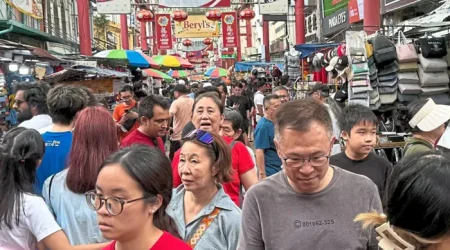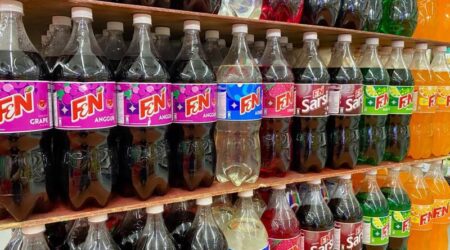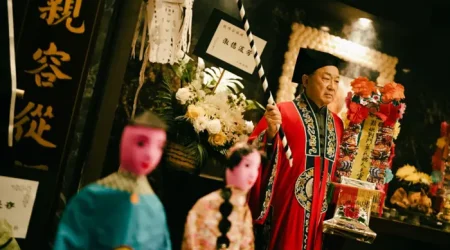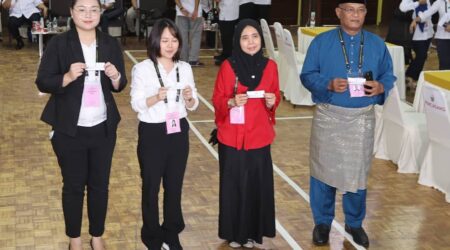Singapore’s classic 1970s HDB lift, Nanyang coffee roasting machine now added to National Collection
SINGAPORE (The Straits Times/ANN): In 1988, about three years after Dominic Chua had started working at Ho Tit Coffee Powder Factory, his father Chua Tock Hoon – the shop’s founder – died following a traffic accident that left him in a coma for 11 weeks.
The suddenness of his dad’s passing meant the business’ genesis was forgotten forever.
“How the business originated, everything from its beginning, like how he came up with the brand’s logo – we have no idea,” said Mr Dominic Chua, 62. “He never said anything.”
While Ho Tit’s origin story – Mr Dominic Chua estimates that his father started the business in the 1950s – was lost along with the late Mr Chua, something he left behind will now be remembered and cherished for years to come.
In April, Mr Dominic Chua donated one of Ho Tit’s coffee roasting machines that dates to the 1970s to the National Collection – an assemblage of objects and artworks that tell of Singapore’s history.
“I have a feeling for these machines, they are like my family. So I don’t want to dismantle and then throw them away,” said Mr Chua, who is in the midst of moving Ho Tit from 402 Upper Paya Lebar Road to a unit a couple of metres away, ahead of Ho Tit’s lease at its first and original location expiring in end-April.

Over the years, many customers have wanted to see the roasting machines, out of curiosity, located in the shop’s back of the house area, said Mr Chua, but each time, he had to turn them down due to food safety concerns.
“Now that I’m moving out, I want someone who can bring it back, keep it, and then show it to people. So my first thought was the museum.”
Mr Chua found a willing recipient in the National Museum of Singapore (NMS).
NMS senior curator Priscilla Chua said Ho Tit is representative of the early generation of coffee roasters in Singapore who produced coffee beans for the traditional Nanyang coffee – or kopi – typically found in coffee shops (kopitiams) in Singapore today.
With kopitiams offering a quintessential experience of everyday life in Singapore today, said Ms Chua, Ho Tit is symbolic of the social historical significance of the local coffee shop culture and “forms an important part of our cultural heritage, both in culinary terms and from a social perspective, given that coffee shops remain key social spaces in Singapore”.
Because of its close connection to local coffee shop culture, NMS chose to take Ho Tit’s machine used for robusta beans – the type used in Nanyang coffee. Another of Ho Tit’s machines, used to roast arabica beans – typically used to brew espresso and other gourmet coffee – will be moved to the shop’s new location to be put on display.
Ho Tit stopped using the machines in 2009 and outsourced bean roasting after Mr Chua’s uncle and brother retired from the business – the roasting process was a three-person job.
The about five-decades-old roasting machine’s requisition is part of the museum’s Collecting Contemporary Singapore initiative, which was launched in May 2020 when NMS – together with the National Library Board – made a public call for objects and stories relating to the Covid-19 pandemic.
While collecting contemporary objects and stories has always been part of NMS’ strategy, said Ms Chua, the initiative represents a more deliberate and concerted effort by NMS to engage the public, as well as crowdsource items and related stories that tell of milestones and events that affect everyday life in Singapore.
Since 2020, the museum has launched several other public calls and exhibitions as part of Collecting Contemporary Singapore – one of the strategies that is part of the National Heritage Board’s ongoing five-year plan, Our SG Heritage Plan 2.0.
In 2022, NMS made a call for technological objects alongside its Off/On exhibition on technology, while it is currently gathering plastic items that have a Singapore origin, complementing the ongoing Plastic: Remaking Our World exhibition.
Ms Chua said that while the definition of contemporary is subject to debate and depends on the context of each artefact, one way to think of collecting such items is “acquiring things that are still happening – still in the present”.
“To be able to do that means responding to whatever pops up,” she added, explaining that this calls for a “rapid response” on the museum’s part, to quickly assess the value of items and the feasibility of acquiring them, as and when the opportunity arises.
Another April acquisition – a Housing Board lift installed in 1978 that was about to be replaced – is a case in point.
On Feb 13, 2024, the museum was informed, through a tip-off from lift enthusiast Wilson Tan and his friends, that the lift in Block 712 Ang Mo Kio Avenue 6 was to be decommissioned.
The NMS team got to work, assessing the lift’s value against a broad set of guidelines that Ms Chua said include the item’s social and historical significance, its display potential and its rarity.
General research, conversations with lift enthusiasts – hobbyists who document and research lifts – and the contractor hired to remove the lift revealed that the lift was the “oldest and last functioning HDB lift of its kind” up until it was decommissioned, said Ms Chua.
HDB told The Straits Times that the lift – located in a four-storey commercial building in Ang Mo Kio Town Centre – was commissioned together with the building in 1979, and had been in operation until it was removed in March.
The lift “helps us to tell the story behind HDB living, not forgetting that Singaporeans back then had to transit from very different living conditions to high-rise buildings”, Ms Chua added.
Mr Tan, who visits blocks with old lifts as a hobby, said he found out about the lift in Ang Mo Kio in late 2021, and since end-2022, visited the town monthly just to ride in the lift.
“The lift has no windows, and being in it makes you feel like you’re visiting an old HDB block,” said Mr Tan, 24, a hospitality and tourism student.
Besides an item’s value, the NMS team also has to assess the logistical feasibility of acquiring it.
Ms Chua said: “It’s quite labour-intensive to process the entire acquisition.”
For instance, prior to taking possession of the coffee roasting machine from Ho Tit, she said the team had to conduct a site visit with vendors to assess how to dismantle it, check in with conservators on which parts to take extra care with, and devise the best strategy to dismantle – and eventually reassemble – the artefact.
Even after such visits, the NMS team frequently has to improvise and adapt on the actual day of collection.
For instance, Ms Chua said the internal workings and parts of Ho Tit’s coffee roasting machine were not visible externally until the day it was to be dismantled, which made it difficult to anticipate any challenges in the dismantling process.
Due to the machine’s age, some parts like heavily rusted screws were difficult to remove, forcing the team to use power tools on occasion.
While documenting and dismantling artefacts, the team also discusses with contractors how best to display the item in future.
In the case of the machine, they decided that a platform could potentially be built to transport it safely, and support it when it eventually goes on display.
On average, Ms Chua estimates that for rapid response acquisitions, the team gets about one to two weeks to make a call on whether to acquire an item.
Ho Tit’s Mr Chua said that beyond donating the machine to the National Collection, he hopes to be able to give inputs on the context in which it will be displayed in the future, so that museumgoers can fully appreciate the machine and how it was used.
The museum and its curators continue to be on the lookout for contemporary items, especially amid a phased revamp of NMS’ permanent galleries.
“We’re constantly thinking of how to make our exhibits a lot more relatable,” said Ms Chua, who added that the museum’s vision is to present narratives that connect various time periods.
“It’s not just about history, it’s also about the present – the contemporary. And that is a very nice link for us to think about the future.” – The Straits Times/ANN















Leave a Reply